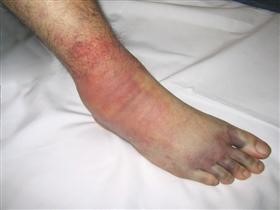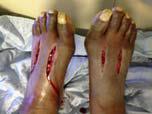Compartment Syndrome of the Foot
Introduction
Crushing injuries are the leading cause of compartment syndrome of the foot. It is usually associated with fractures of the foot or a midfoot fracture-dislocation. Many studies link this condition to high energy trauma as a result of a motor vehicle accident (MVA) causing serious injury like Lisfranc fractures. This condition is also common in calcaneal fractures of the foot as a result of a fall from a height.
Clinical Presentation
Patients with compartment syndrome of the foot report intense pain, bruising (ecchymosis), and swelling. Numbness and tingling or pins and needle feeling is not uncommon. Significant swelling of the muscles of the foot and may be restricted by the dense fibrous tissue (fascia) that surrounds each “compartment” of muscles. This can result in increased pressure in the muscle tissue – and subsequently a lack of blood supply and oxygenation to these tissues. If this is not treated in time eventually muscle death can occur.
There are nine compartments to the foot. Each contains a group of muscles. When compartment syndrome of the foot does occur, it is common for many, or all, of these compartments to be involved.
Physical Exam
On examination, the foot is usually markedly swollen and the muscles are tense (Figure 1). An associated traumatic injury to the foot is usually present. In severe cases, there may also be a decrease in sensation to the toes. Movement of the toes will create significant pain in the foot for conscious patients.
Figure 1: Swollen foot following trauma

Imaging Studies and Diagnosis
X-rays will demonstrate the associated underlying foot injury, but will not be able to specifically diagnose the compartment syndrome.
Diagnosis is usually made after an accurate clinical evaluation combined with compartmental pressure monitoring. Pressure monitoring that demonstrates pressures within the compartment that are less than 20-25 mm of mercury less than the lowest aspect of the blood pressure (diastolic pressure) is suggestive of compartment syndrome.
Treatment
It is best to suspect a diagnosis of acute compartment syndrome of the foot in any patient with high-energy trauma. Typical signs and symptoms may be absent, especially if there are distracting injuries or the patient has an altered level of consciousness. Once suspected, the initial treatment should include removing all restrictive dressings.
Specific treatment for compartment syndrome is controversial. The muscles of the foot are small. It is always difficult to know the extent to which they are involved. If compartment syndrome does result in muscle death overtime, the resulting sequelae will be significant clawing of the lesser toes, and possibly pain and dysfunction in the foot.
If compartment syndrome is diagnosed, surgical release may be required. This involves opening up the various compartments of the foot through a series of 3 or 4 incisions (2 on the top, 1 on the side as necessary) to release the swollen compartments (Figure 2). Releasing the strong fibrous tissue that encases the muscle compartments on time will allow blood to flow to the compartment to maintain the tissue circulation and oxygenation. However, it is relatively common for compartment syndrome of the foot to develop without being identified. If this does occur, then over time the toes will become clawed. In severe cases the foot may be dysfunctional if widespread death of the muscles of the foot has occurred.
Figure 2: Incisions on the top (dorsum) of the foot used to release these muscle compartments of the foot.

Late Treatment
Claw toe or hammer toe correction surgeries may be recommended if these deformities cause dysfunction and interfere with wearing shoes in this group of patients.
Edited by Stephen Pinney, MD October 15th 2025. Previously edited by Kalpesh Shah, FRCS and Hossein Pakzad, MD, FRCSC, FAAOS.